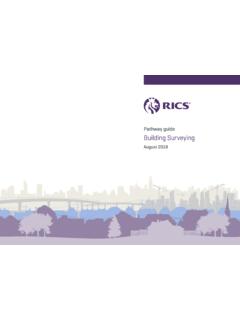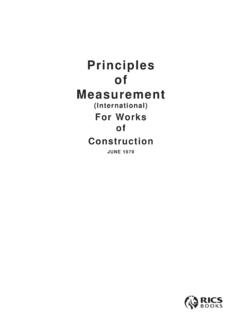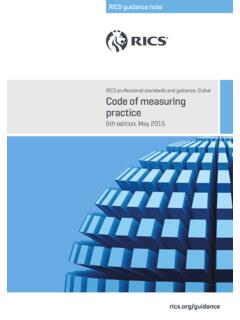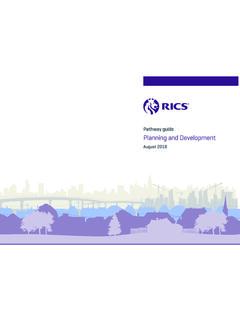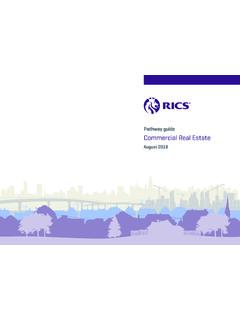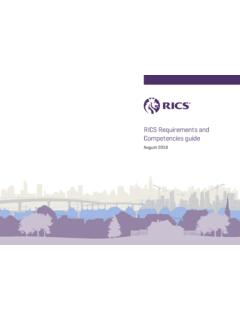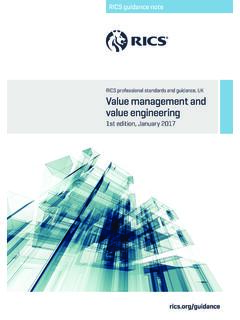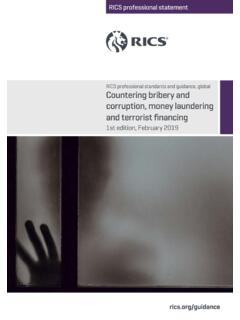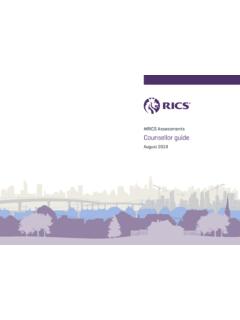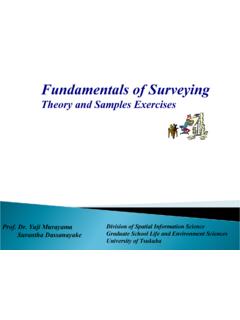Transcription of Guidelines for the use of GNSS in surveying and mapping
1 Practice Standards, UK2nd edition, guidance noteGuidelines for the use of GNSSin land surveying and mapping2nd edition, guidance noteThis guidance note sets out best practice Guidelines for surveyors andclients on the use of Global Navigation Satellite Systems(GNSS) inland surveying and provides the surveyor with a set of practical operational Guidelines , whichcan be used when undertaking any survey that includes GNSS also provides clients and purchasers of geospatial information generatedfrom a GNSS survey with sufficient information to write a task specificspecification for a GNSS survey. This sets out the accuracy requirements,final potential products and scope of work, from which the surveyor canproduce an agreed specification and bid for a survey. This 2nd edition alsodeals with recent advances in GNSS capabilities such as commerciallyavailable RTK systems, SBAS and other augmentation systems, satelliteconstellation and its effects on precision and the effects of factors such asthe troposphere and tidal loading.
2 The document is divided into two parts. Part 1 summarises the importantcriteria to be considered in GNSS surveying , and includes Guidelines forbest practice. Part 2 is a technical explanation which develops thethemes of Part 1 in a more formal context. This is primarily intended forsurveyors and clients who wish to understand some GNSS theory andthe technical rationale behind the best practice Guidelines . The documentas a whole is a must read for all chartered surveyors who are interestedor are already using GNSS/GPS technologies. The following topics are covered: The role of GNSS in surveying The role of RTK and commercially available networks survey documentation survey operations survey methods Operational considerations Co-ordinate reference frames Quality issues Guidelines for the use of GNSSin land surveying and mappingGN 13/2010 Guidelines for the use of GNSS in landsurveying and mappingRICS guidance note2nd edition (GN 11/2010)Published by the Royal Institution of Chartered Surveyors (RICS)
3 Surveyor CourtWestwood Business ParkCoventry CV4 responsibility for loss or damage caused to any person acting or refraining from action as a result of the material included in this publication canbe accepted by the authors or by the Land Professional Group of the Royal Institution of Chartered edition published 2002 asGuidelines for the use of GPS in land surveyingISBN 978 1 84219 607 6 Royal Institution of Chartered Surveyors (RICS) June 2010. Copyright in all or part of this publication rests with RICS, and save by prior consentof RICS, no part or parts shall be reproduced by any means electronic, mechanical, photocopying or otherwise, now known or to be in Great Britain by Columns Design Ltd, Reading, BerksPrinted in Great Britain by Annodata Print Services, Dunstable, BedsContentsRICS guidance notes1 Preface2 Part 1 Guidelines41 The role of GNSS in GNSS in Survey Survey methods6 Tables82 GNSS survey Client Surveyor s procedures163 GNSS survey Fieldwork and Data Co-ordinate Essential considerations for GNSS surveys17 Tables18 Part 2 Technical commentary284 GNSS survey General Static Dynamic Real-time dynamic surveys345 Operational Atmospheric Interference and other operational considerations396 Co-ordinate reference Description of the Co-ordinate Co-ordinate transformations447 Quality Survey Survey Field Quality control of real-time Office procedures55 Guidelines FOR THE USE OF GNSS IN LAND surveying AND mapping | iiiAppendices59 AGNSS verification.
4 Testing and maintenance59 BInformation on receiver types60 CFurther reading61 DSample specification with specific GNSS clause63 ESample procedures relating to a GNSS survey64 Glossary65 Checklist for GNSS survey specification and procedures74iv | Guidelines FOR THE USE OF GNSS IN LAND surveying AND MAPPINGRICS guidance notesThis is a guidance note. It provides advice tomembers of RICS on aspects of the procedures are recommended forspecific professional tasks, these are intendedto embody best practice , that is, procedureswhich in the opinion of RICS meet a highstandard of professional are not required to follow the advice andrecommendations contained in the guidance should, however, note the following an allegation of professional negligence ismade against a surveyor, the court is likely to takeaccount of the contents of any relevant guidancenotes published by RICS in deciding whether or notthe surveyor has acted with the opinion of RICS, a member conforming tothe practices recommended in this guidance noteshould have at least a partial defence to anallegation of negligence by virtue of having followedthose practices.
5 However, members have theresponsibility of deciding when it is appropriate tofollow the guidance. If it is followed in aninappropriate case, the member will not beexonerated merely because the recommendationswere found in an RICS guidance the other hand, it does not follow that amember will be adjudged negligent if he or she hasnot followed the practices recommended in thisguidance note. It is for each individual charteredsurveyor to decide on the appropriate procedure tofollow in any professional task. However, wheremembers depart from the good practicerecommended in this guidance note, they shoulddo so only for good reason. In the event oflitigation, the court may require them to explain whythey decided not to adopt the addition, guidance notes are relevant toprofessional competence in that each surveyorshould be up to date and should have informedhim or herself of guidance notes within areasonable time of their FOR THE USE OF GNSS IN LAND surveying AND mapping |1 PrefaceThis second edition of theGuidelines for the use ofGNSS in surveying and mappingis published bythe Royal Institution of Chartered Surveyors underthe aegis of the mapping and Positioning PracticePanel (MAPPP).
6 The guidance note forms part of aseries of specifications and Guidelines intended toassist all those connected with the requesting,purchase and production of surveys and mappingmaterial at all scales, by spreading good practiceand seeking to avoid duplication of effort. TheMAPPP is one of the foremost technical practicepanels within RICS and is comprised of private andpublic sector surveying and mapping industryexperts, academics and survey instrumentmanufacturers. This broad expertise enablesMAPPP professional/technical guidance and outputto adhere to industry best survey specifications, this document isintended to provide best practice guidance onlyand is not intended to be incorporated verbatiminto the text of individual contracts. However, thewording of individual paragraphs and the surveyorand client checklists can be so used, and copyrightprovisions are waived solely for this are a number of other publications related tothe full range of land surveying services:+Surveys of Land, Buildings and Utility Servicesat Scales of 1:500 and Larger: ClientSpecification Guidelines (2nd edition), 1996+Measured Surveys of Land, Buildings andUtilities Client Specification Guidelines (proposed 2010)+Vertical Air Photography and Derived DigitalImagery: Client Specification Guidelines (5thedition) 2010+Terms and Conditions of Contract for LandSurveying Services (3rd edition) 2009 MAPPP also produce a full range of geomaticsclient guides, including one specially on GPS RTKnetworks, and public guides.
7 A full listing ofrelevant GPS-related RICS professional informationand other publications can be found withinAppendix C. All MAPPP output and furtherinformation on the panel can be found and MAPPP would like to thank the followingmain authors and reviewers of this second edition:+Richard Groom FRICS, lead author and MAPPP Environment Agency+Paul Cruddace MRICS, MAPPP OrdnanceSurvey+Dr Stuart Edwards MRICS, vice chair RICSG eomatics International Professional GroupBoard, University of Newcastle+Mark Breach FRICS, MAPPP NottinghamTrent University+Simon Kraetor MRICS, MAPPP BlomAerofilms+Stuart Trigg FRICS, MAPPP Blom Aerofilms+James Kavanagh MRICS, RICS Director ofLand Group2| Guidelines FOR THE USE OF GNSS IN LAND surveying AND MAPPINGI ntroductionThis guidance note has been produced to providesurveyors and their clients with Guidelines for theuse ofGlobal Navigation Satellite Systems(GNSS) in land surveying .
8 The first edition of theseguidelines referred to (Global PositioningSystems) GPS, which at the time was the onlyconstellation in operation and available tosurveyors. This edition uses the term GNSS throughout, to reflect the fact that there is nowmore than one satellite navigation systemconstellation available and that there are GNSS receivers on the market that can use data frommultiple document has been written primarily with twogoals in mind:+to provide the surveyor with a set of practicaloperational Guidelines , which can be used whenundertaking any survey that includes GNSS techniques. Sufficient information is alsoincluded to allow the surveyor to generate a setof GNSS survey procedures applicable to asurvey task required by the client+to provide the client, or purchaser of spatialinformation generated from a GNSS survey,with sufficient information to write a taskspecific specification for a GNSS survey whichsets out the accuracy requirements, productsand a scope of work, from which the surveyorcan accurately produce a bid for the is seldom the case that a survey will compriseGNSS techniques alone.
9 This guidance note shouldbe used with the appropriate client specificationguidelines document for the scale of the survey. Forexample, a 1:500 topographic survey of a 5kmpipeline route can be specified with the RICS documentSurveys of Land, Buildings and UtilityServices at Scales of 1:500 and Larger; it should benoted that this specification will be superceded byMeasured Surveys of Land, Buildings and Utilitiesin2010/11. These Guidelines should then be used inconjunction to provide best practice information onthe particular aspects of the survey reliant uponGNSS techniques. Surveyors may also find it usefulto refer to the MAPPP client guide on GPS, Virtually right networked GPS , available and in the case of surveyorsin Great Britain, the information on the GB NationalGNSS Network, available at addition to the above purposes, these guidelinescan be used as a general reference document andas a practical operational handbook , tosupplement other more academic texts on guidance note is divided into two parts.
10 Part 1serves as a summary of the important criteria thatshould be considered in GNSS surveying and canbe read quickly to grasp the fundamental conceptsand issues related to GNSS surveys. It includessummary information and actual Guidelines for bestpractice. Part 2 is a technical explanation whichdevelops the themes of Part 1 in a more formalcontext. This is primarily intended for surveyors andclients who wish to understand some GNSS theoryand the technical reasons behind the good Guidelines adopt a standard nomenclature forthe many terms that are found in GNSS GNSS survey techniques have developed overtime, the manufacturers, universities undertakingresearch and individuals involved have all adopteddifferent and sometimes confusing terms. Inparticular, standard terms for survey methods havebeen adopted. A glossary of the technical terms isprovided at the end of the survey Guidelines are concerned with theland survey applications of GNSS, and do notattempt to cover specific hydrographic or aerialpositioning requirements.

